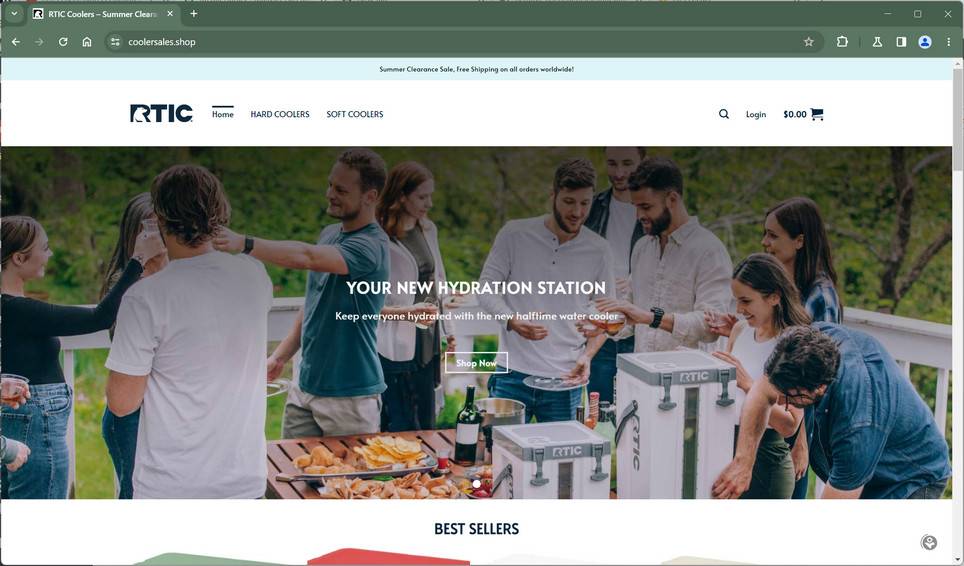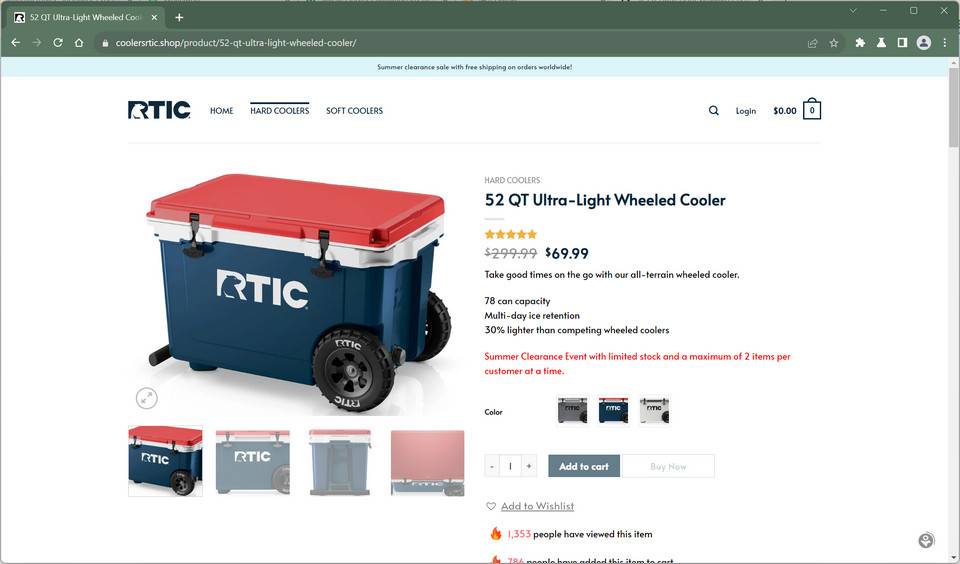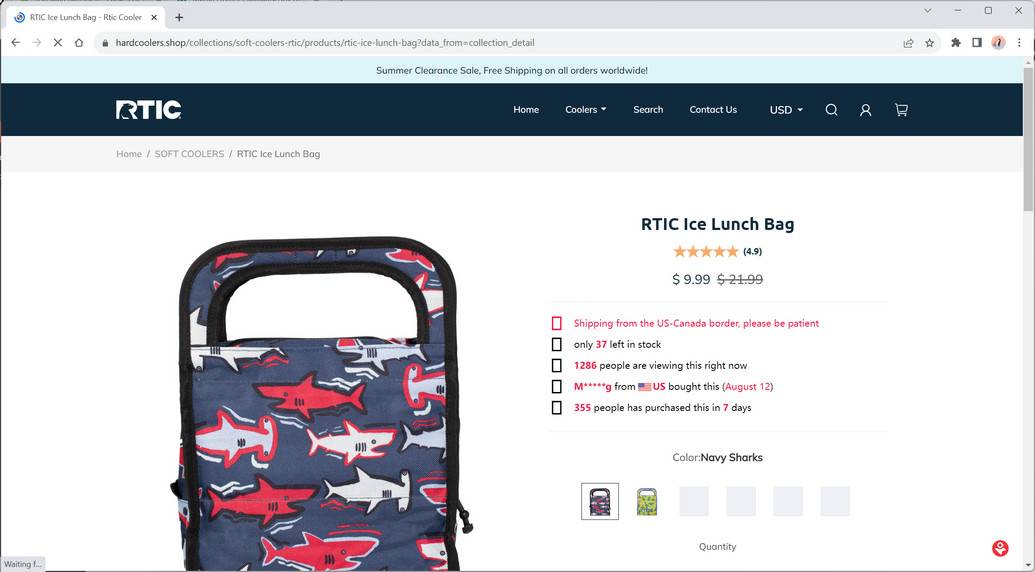As a premier cooler brand offering affordable rotomolded performance rivaling the most premium market offerings, RTIC has unfortunately become the latest target of elaborate clearance sale scams promoted online. Sophisticated fake websites and social media ads falsely claiming to offer extreme RTIC discounts up to 90% off popular items aim to dupe shoppers. This guide breaks down exactly how this scam ensnares victims plus tips to avoid exploitation.



Overview of Fake RTIC Clearance Sales Scamming Shoppers
The real RTIC brand needs little introduction, having disrupted the cooler industry by making professional grade ice chests accessible to any budget since 2015. However, RTIC’s trusted reputation is now attracting elaborate clearance sale scams.
Highly-convincing fake RTIC websites engineered to closely mimic RTIC’s real online store down to matching logos, product shots and web design are being heavily promoted through social media ads. They tout unrealistic limited-time blowout cooler markdowns up to 90% off to generate interest and website traffic.
Common Clearance Scam Warning Signs:
- Extreme 90%+ discounts too good to be true
- Suspicious URLs slightly differing from real sites
- Poor grammar, spelling errors and unprofessional site text
- Non-working customer service phone numbers
When lured onto these deceptive clearance domain knockoffs instead of legitimate RTIC sites themselves, victims who place orders overwhelmingly report profound disappointment through:
- No items shipped – Most likely outcome after payments processed
- Cheap knockoffs – Low-quality fakes that don’t match product images/descriptions
- Used or damaged goods – Showing clear signs of abuse
- Random wrong items – Products never even ordered!
And adding insult to injury, users’ personal and financial data also gets stolen during checkout on these elaborate sham websites enabling additional downstream identity theft by fraudsters.
By understanding the cunning techniques these sophisticated RTIC clearance scams deploy online, shoppers can sidestep their tricks and securely shop real websites.
Step-By-Step Anatomy of Fake RTIC Clearance Sales Scamming Victims
Successfully scamming shoppers using counterfeit RTIC online promotions requires coordinated planning and execution. Here is exactly how innocent victims get duped:
1. Scammers Engineer Fake “RTIC” Websites
Sophisticated scam artists architect intricately designed replica RTIC websites made to closely imitate the cooler brand’s real online shop.
While URL addresses appear legitimate initially, they actually utilize similarly named domains diverting away from real stores:
rticoutletstore.online
rticblowoutsale.shop
rticwebsaleretail.websiteThe elaborate fake sites similarly use RTIC’s exact logo, product galleries and familiar website navigation – while barely differing enough to control lookalike domain names fraudulently.
2. Bogus RTIC Ads Promoted Via Social Platforms
Fraud ring operators then promote their network of sham RTIC domains using compelling social media ads highlighting unbelievable discount messaging to fool users. These primarily leverage Facebook, Instagram and YouTube with their immense reach.
The ads display exaggerated headlines like “RTIC discontinuing products – clearance sale offers discounts up to 90% off before inventory gone!” Links route through obscured URL shorteners masking the scam destinations.
When social media users click on these advertisements, they get redirected to the sophisticated fake clearance stores instead of legitimate websites.
3. Shoppers See Outrageous Prices Slashed Over 90% Off
Upon landing on the convincing duplicate RTIC domains instead of real sites, visitors behold what appears as incredible clearance sales boasting extreme 90%+ reductions.
Genuine $300 RTIC coolers all show insanely marked down to just $29 – making premium outdoor gear seem almost free compared to standard retail rates which rarely discount.
Such irrational price points are shown next to much higher normal pricing for authenticity. This further fools visitors into assuming the blowout deals are authorized limited-time fire sales.
4. Checkout Forms Steal Users’ Personal and Financial Data
As shoppers rush to lock unbelievable deals, mandatory order forms demand extensive sensitive customer data including:
- Full legal names
- Home addresses
- Phone numbers
- Credit card numbers
- Security codes
- Expiration dates
This mined contact/payment data flows directly to sophisticated scammers rather than legitimately securing clearance grab deals.
5. No Orders Fulfilled or Terrible Products Received Instead
Soon victims find they got scammed since clearance orders never arrive. Instead purchases either:
- Vanish entirely after payments with zero fulfillment
- Extremely poor quality knockoffs get shipped instead
- Used, defective merchandise arrives instead
- Random wrong products show unrelated to order specifics
Now victims lack real merchandise while fraudsters possess both stolen money and sensitive personal data enabling additional downstream identity theft.
How to Spot the Fake RTIC Clearance Websites
While scam sites tout unbelievable markdowns, closer inspection reveals their fraudulent tactics once aware.
Analyze Website URLs
Fake domains barely differ from the real RTICcoolers.com:
rticoutletshop.online
rticblowoutsale.store
rticclearancehub.website Most are recently created in 2021/2022 based on domain age checks.
Review Contact Information
No physical addresses or phone numbers provided by sites – only dubious email addresses:
support@rticoutletshop.online
service@rticblowoutsale.store Non-transparency signals shady operations.
Assess Pricing Claims
Prices seem unbelievable compared to normal RTIC rates. Coolers are discounted from $300+ down to just $39 making the deals seem improbable.
Scrutinize Branding and Slogans
Signature RTIC branding/fonts and slogans used liberally:
- “Going out business forever!”
- “Limited-time free shipping”
But branding appears edited when inspected closely exposing fakery.
Staying observant for these fake signals makes avoiding clearance cons easier when bargain hunting online.
What To Do If Scammed By a Counterfeit RTIC Blowout
If you unfortunately fell for fake RTIC cooler clearance cons while shopping online, take these steps immediately to mitigate damages:
Report Fraudulent Transactions: Contact the credit card provider used on scam sites ASAP. Request they reverse any illegal purchases for undelivered goods. Provide details surrounding sham websites and failed delivery.
Initiate Credit Reports Freeze: Freeze reports at Equifax, Experian and Transunion stopping criminals opening unauthorized new accounts with stolen information.
Monitor Financial Account Activity: Watch statements routinely for fraudulent charges indicating potential post-scam identity theft. Notify institutions immediately regarding any suspicious transactions.
Report Fake Websites: Submit details on scam websites encountered to the FBI’s IC3 Complaint Center and FTC’s reporting page to combat retail cons stealing hard-earned consumer dollars.
Getting exploited by online shopping scams feels awful. But responding swiftly helps restrict damages while preventing additional trickery by freezing credit and reporting retail fraud.
Frequently Asked Questions About Fake RTIC Clearance Sales
Concerned about fraudulent RTIC cooler clearance sales conning shoppers online? Here are answers addressing the top 10 questions around identifying and avoiding this outdoor gear scam:
1. Are the RTIC 90% off clearance sales on Facebook legitimate?
Unfortunately, most are completely fake. Scam ads route traffic to elaborate counterfeit websites stealing personal/financial data instead of enabling real sales. Always verify URLs match official RTIC domains before engaging clearance ads.
2. What are signs of a fraudulent RTIC clearance website?
Warning signs include non-RTIC URLs, recent domain creation, subtle branding issues in logos/fonts, unprofessional errors in site text, mismatching images and no working customer service contacts.
3. What happens if you order from a counterfeit RTIC clearance domain?
Most likely your order disappears entirely post-payment and nothing ever ships out. In other cases, victims received flimsy knockoffs, used goods or random products unrelated to original orders. Plus all submitted personal data gets stolen enabling future identity fraud exploits.
4. Can scam victims get money back from fake websites?
If you paid by credit card, immediately file a fraud complaint requesting reversal of charges. Unfortunately protections covering international counterfeit purchases may be limited. Prevention is key, so always thoroughly vet retailers and pricing legitimacy before handing over payment data.
5. How can I avoid RTIC clearance sale scams moving forward?
Carefully check site legitimacy and URLs before checkout. Official RTIC domains must match their real website address precisely. Additionally realize unbelievable discounts like 90% off are always indicators of fraudulent RTIC sales, regardless of branding and imagery used.
6. Will my data get stolen from ordering on counterfeit sites?
Possibly – we strongly advise placing fraud alerts on credit reports, monitoring accounts routinely and securing credentials if exploited. Stolen financial information enables various identity theft ploys by fraudsters.
7. Where should I report fake RTIC websites?
To prevent victimization of more shoppers, report fraudulent sites and sellers to the FBI’s IC3 complaint center and FTC’s reporting page. Include all website and order details.
8. How can I determine if an RTIC website is fraudulent?
Scrutinize URLs, domain details, product pricing/imagery mismatches, grammar errors, broken contact forms, unbelievable blanket sale claims and stolen branding assets. If anything seems unreasonable compared to normal retailer practices, it likely signals a scam.
9. What’s an example of a fraudulent RTIC website URL?
RTICproductsales.coFraud sites mimic the real RTIC URL extremely closely so examination is imperative before providing payment/personal data anywhere.
10. Who should receive reports of counterfeit websites?
Submit website details, screenshots and transaction records to the Internet Crime Complaint Center (IC3.gov), RTIC corporate and affected payment providers to aid investigations and prevention efforts against brand impersonation scams stealing hard-earned consumer dollars.
Stay vigilant online – if an advertised deal seems improbable or unrealistic, it likely is given normal retail margins andoperations. Verify legitimacy carefully at every step.
The Bottom Line – Verify Before Providing Data to RTIC Blowout Claims
As RTIC retains immense popularity for delivering professional grade cooler performance without breaking budgets, their trusted branding remains an alluring target for clearance sale scammers seeking to trick shoppers through elaborate cons. But proactively verifying legitimacy remains the best scam prevention.
Carefully check URLs match RTIC’s real domain while watching for other common warnings covered here before assuming authenticity. And never submit personal/financial data without thoroughly vetting sites first, even if branding appears officially affiliated on the surface.
Question improbable rock bottom pricing on limited quantity clearance items. Using reasonable skepticism makes avoiding retail cons easier. Think twice when unbelievable deals arise unexpectedly.










